本文来源:http://blog.sciencenet.cn/home.php?mod=space&uid=1475614&do=blog&id=926687
大自然将奥秘或法则隐匿于一套密码之中,籍此创作出数以千万计的物种,之后又将其销毁,终而复始,生生不息……虽然遗传密码子的破译已过去了半个多世纪,但对它的起源人们依然一无所知,有人甚至宣称这是不可知的(unknowable),另一些人则认为它源自外来的设计(external design)。生命/遗传密码子的起源被誉为现代生命科学的最大谜团之一,但它却关乎人们对生命本质与演化的认知。如何才能揭开这一世纪之谜……
一、生命=物质(质量+能量)+信息
生命具有十分杂遝的表象,其生化系统也是极为复杂。它历经了数十亿年的演化之旅,从简单的细菌、虫草扬升到具有复杂精神与情感的人类。撇开纷繁的衍生之物,生命的本质其实十分简洁:生命=物质(质量+能量)+信息。
1. 生命——既是物质,亦超越物质
宇宙中的万物(物质)都是质量和能量的复合体,生命亦如此,只是还有另一种特性——信息,也就是说,生命=质量+能量+信息。生命既然是物质的,它就必须遵循物质世界的基本规律——质量守恒,能量亦如此。当然,在特殊情况下,质量和能量之间亦可相互转化。生命既是物质,亦超越物质,因为它开始产生与累积信息。
化学在分子和原子的层次上研究物质的组成、结构和性质以及它们的变化规律,细分为无机化学、有机化学、物理化学、分析化学和生物化学等。而专门以生物为对象的化学称之为生物化学,它研究生命的物质组成、生物分子的结构、功能及其变化(代谢)。
在生物化学中有两个重要领域——生物能量学和生物信息学,前者讨论与能量有关的各种代谢过程,后者关注信息大分子的结构、功能和复制等问题。但是,它们的共同之处都是只关注运作/工作机制,而不管它们是如何起源的。知道一件事的工作原理并不意味着就能知道其来源,这在生命科学中司空见惯。
2. 生命——物理化学过程的产物
生命的起源可归结于细胞的起源,那细胞是如何起源的呢?细胞被双分子层磷脂组成的薄膜所包裹(图1)。地球上的生命不可能源于某种预先的设计,它必定是物质世界之物理化学过程的产物。因此,自发生成的脂质囊泡(这是脂类在水溶液中的一种自然特性)及其所随机包裹的生命构件应该就是生命演化的始点。原始地球上必定存在了基本的化学构件(如ATP这样的核苷酸、氨基酸、脂肪酸、糖类等),否则就会掉进设计论的陷阱(谢平2014)。
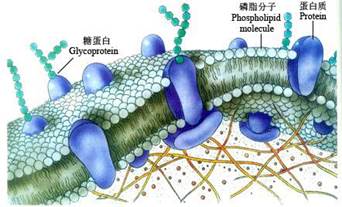
图1 细胞膜的结构(引自互动百科)
脂类与蛋白质通道的耦联使细胞膜具备了对物质的选择通透性,便于对物质交流的管控。在悬浮于水溶液的这种膜结构中,太阳光能反复的随机性刺激,驱动了这种个性化结构中电子与质子的流动,拉开了元素重组的大幕,由于这种膜结构对物质进出的非均衡性影响,容易导致大分子有机物质的积累与囊泡破裂,逐渐推动细胞分裂机制的形成、细胞内化学反应的秩序化与信息化,发展出个体性稳定传递的机制(即遗传),并最终迎来了具有现代生命特征的活细胞的降临。简而言之,生命始于水环境中光能驱动下的物质转换,即伴随着电子和质子流动的元素重组。太阳光能为地球上生命的起源、运动与发展提供了根本动力。
液态水肯定是生命演化的必须条件,首先,从地球以外的其它行星的情况来看,没有液态水,也未见生命存在的迹象。此外,水也是地球上生命的主要组分,地球上没水的地方,生命亦不会存在。生物体内的生化反应均需以水为媒介。当然,由于缺少化石证据,人们现在还不清楚最初的生命在何时、何地以及如何出现的,甚至无法确认到底生命起源于海洋还是淡水。
太阳系中的地球可谓得天独厚,它坐拥大量的液态水,而且这些水在固—液—气态之间不停地循环。这可能得益于地球在太阳系中占据了幸运的位置——如果离太阳太近的话,水将蒸发殆尽,如果太远的话,水只能以冰的形式存在。
从化学上来看,生命的成功就在于它在液态水环境中发展出了将太阳光能转化为化学能的机构,核心之处就在于它构建了一个以ATP(三磷酸腺苷,图2)为化学能载体的细胞生化代谢体系。但是ATP并不是太阳光能的直接产物:其生成需要质子(H+)的跨膜梯度,因此,需要具有相对封闭性的像脂质囊泡这样的结构。
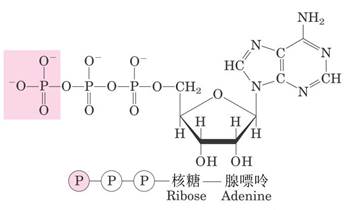
图2 三磷酸腺苷(ATP)的结构,通过磷酸酐键的断裂移去ATP末端的磷酸基团将释放高的能量,这在细胞中与许多吸能反应相耦联(如粉色区域所示)(引自Nelson & Cox 2004)
利用跨膜H+梯度,将ADP和Pi成功地合成ATP,这可能是地球生命史上的一个重要事件。ADP和ATP应该是地球早期存在的生命构件,而ATP合成酶(ATPase)是后来演化的产物。形象地说,ATP-ADP就似一个微电池,ATP放电变成ADP,而ATPase似一个充电器,其电能则来自跨膜的H+梯度。大量的H+恰好是太阳光能裂解水的产物,同时,裂解水产生的电子也需要进行跨膜传递,这是借助一系列电子载体来实现的,即所谓的电子传递链(图3)。
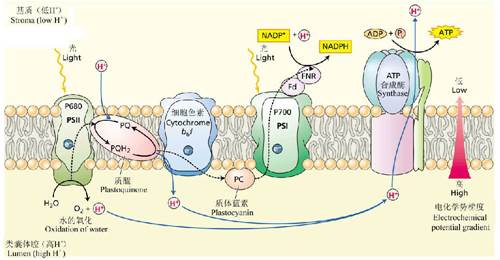
图3 在内囊体膜上,与光合作用耦联的ATP合成示意图(引自Taiz and Zeiger 2010)
3. 信息与密码——只属于生命
生命的独特本质之一就是获得了将物质信息化的能力,即将自身的生命过程储存于一种特殊的信息分子DNA(脱氧核糖核酸)之中。离开了生命世界,信息将毫无意义,因此,信息一定是生命的信息。对非生命世界来说,存在的只是物质的状态以及它们运动变化或相互转化的规律或法则。
何谓信息呢?笔者十分欣赏控制论的创始人、美国数学家维纳(Norbert Wiener)的精辟定义:“信息是人们在适应外部世界,并使这种适应反作用于外部世界的过程中,同外部世界进行互相交换的内容和名称”。信息论的奠基人、美国数学家香农(Claude Elwood Shannon)的定义也耐人寻味:“信息是用来消除随机不确定性的东西”。无论是探讨生命的起源还是之后的演化,都不该忘记这样的生命禀性。
在物质世界中,有了信息及其记载,历史才有意义。可以这样说,生命的诞生以信息系统的成功建立为标志,即出现了记载可重现的个体发育信息的大分子——DNA(通过三联体密码子编码氨基酸)。这种生命构建的可重现性就是所谓的“遗传”。
构成DNA的碱基有4种,而一个氨基酸由3个碱基所决定,这样碱基的理论组合有43 =64种。实际上还有3个终止密码子(不编码氨基酸),因此,共有61个编码氨基酸的密码子。可是,构成蛋白质的氨基酸只有20种,这样,大多数氨基酸都有几个三联体密码(2—6个不等),这就是所谓的简并性,编码同一种氨基酸的密码子互称同义密码子,已知同义密码子在生物界中被使用的频率不尽相同。这种简并性可能起因于相似的立体化学特征。
一般来说,同义密码子的第1、2位碱基大多是相同的,只是第3位不同。譬如,ACU、ACC、ACA和ACG都编码苏氨酸,UGU、UGC、UGA和UGG都编码缬氨酸。这样,生物体对第3位碱基的点突变就具有更强的耐受性,或者说,同义密码子越多,相应的遗传稳定性越大。
还有三种核糖核酸——信使RNA(mRNA)、核糖体RNA(rRNA)和转运RNA(tRNA),分别负责遗传信息的转录、氨基酸的转送和蛋白质的合成。已知的tRNA共有61种,即每个能编码氨基酸的密码子都有一个相对应的tRNA(图4)。而一种tRNA只能携带一种氨基酸(如丙氨酸tRNA只携带丙氨酸),这样,一种氨基酸可被不止一种的tRNA所携带。DNA双螺旋中的碱基配对严格:A—T,G—C,但tRNA反密码子与mRNA的密码子之间的配对偶尔会出现摆动(wobble)现象。
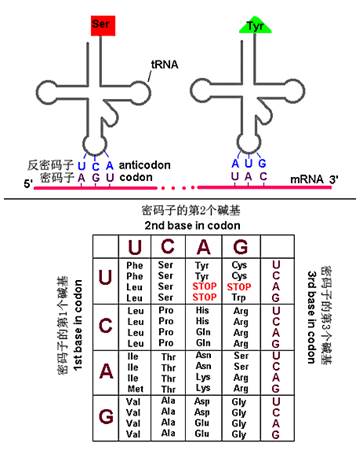
图4 三联体密码表以及tRNA的反密码子和mRNA的密码子的配对
二、关于遗传密码起源的各种学说
可以说,遗传密码匿藏了生命及其历史的秘密。因此,如果人们知道了密码子是如何产生的,生命起源的难题也就迎刃而解了。迄今为止,已提出了各式各样的假说。
1. 凝固事件假说(frozen accident hypothesis)
英国分子生物学家克里克(FrancisCrick,DNA双螺旋的发现者之一,1962年获诺贝尔生理学或医学奖)提出了凝固事件假说,认为密码子与氨基酸的关系是在某一时期固定的,之后很难再被改变(Crick 1968)。现在所有的生物几乎使用着同样一套密码似乎支持这一假说,这也表明,所有生物起源自单一的共同祖先。笔者认为,这只是对演化事件时间节点的一种推测,并未说明密码系统是如何起源的。
德国化学家艾根(Manfred Eigen,1967年获诺贝尔化学奖)也表达了类似的想法:“在达尔文物种进化的前面,还有一个类似的分子进化的渐进过程,由此导致了唯一的一种运用普适性密码的细胞机构。这种密码最终确定起来,并不是因为它是唯一的选择,而是由于一种特殊的‘一旦——永存’选择机制,可以从任何随机分配开始”(Eigen & Schuster 1979)。
2. 立体化学假说(stereochemical hypothesis)
美国微生物学家和生物物理学家韦斯(Carl Richard Woese,生命“三域”学说和RNA世界学说的提出者)等提出了立体化学假说(Woese et al. 1966),认为氨基酸与它们相对应的密码子有选择性的化学结合力,即遗传密码的起源和分配与RNA和氨基酸之间的直接化学作用密切相关,或者说,密码子的立体化学本质取决于氨基酸与相应的密码子之间物理和化学性质的互补性。
奥地利学者Polyansky等(2013)通过实验和计算发现,mRNAs中不同核酸碱基的密度分布,非常类似于它们所编码的蛋白质中这些相同核酸碱基的氨基酸亲电子密度分布,遗传密码进行了高度最佳化,以最大化这种匹配。
笔者认为,立体化学假说接近了密码子起源的一个重要节点,但还无法诠释一个完整的机制。试问,到底密码子是在何种动因的驱动下演化而来的呢?
3. 共进化假说(co-evolution hypothesis)
长期从事基因密码研究的华裔学者王子晖(J. Tze-FeiWong)提出了共进化假说(Wong 1975),认为密码子系统有原始氨基酸形成的前生物代谢途径的印迹,因此可以从氨基酸代谢途径发现密码子的演变过程,即密码子的进化与氨基酸生物合成的进化是并列的。该假说认为,氨基酸和相应编码的忠实性反映了氨基酸生物合成路径的相似性,并非物理化学性质的相似性。笔者认为,这也只是在推测密码子起源的一种可能路线,并未说明为何如此演化,此外,从简单的原料合成各种氨基酸可能是发生在前生命演化末期的事情了。
4. 综合进化假说
美国学者Knight等(1999)提出遗传密码进化的综合性假说,认为遗传密码是由选择(selection)、历史(history)和化学(chemistry)三个因素在不同阶段起作用的。该假说认为,在遗传密码起源初期,可能主要是氨基酸和密码子之间的直接相互作用来决定氨基酸的编码;在新氨基酸的引入和密码子扩展阶段,共进化作用可能占据主导地位;而随着tRNA的进化和蛋白质的功能增加,逐渐去除了氨基酸和密码子的直接相互作用,密码子在不同尺度上的交换在某些程度上允许通过密码子的重新分配进行优化(肖景发和于军2009)。这是对几种主要假说的综合,依然未能涉及演化的动因。
5. 其它假说
1981年艾根提出了试管选择(in vitro selection)假说,1989年英国化学家奥格尔(Leslie Eleazer Orgel)提出了解码(decoding)机理起源假说,1988年比利时细胞生物学和生物化学家杜维(Christian de Duve,1974年获诺贝尔生理学或医学奖)提出了第二遗传密码(secondgenetic code)假说。
英国巴斯大学的Wu等(2005)推测,三联体密码从两种类型的双联体密码逐渐进化而来, 这两种双联体密码是按照三联体密码中固定的碱基位置来划分的, 包括前缀密码子(Prefixcodons)和后缀密码子(Suffixcodons)。不过,也有人推测三联体密码子是从更长的密码子(如四联体密码子quadrupletcodons)演变而来,因为长的密码子具有更多的编码冗余从而能抵御更大的突变压力(Baranov etal. 2009)。
2007年中国科学院北京基因组研究所的肖景发和于军(Yu 2007,Xiao and Yu 2007)提出了遗传密码的分步进化假说(stepwiseevolution hypothesis),认为最初形成的遗传密码应该仅仅由腺嘌呤A和尿嘧啶U来编码, 共编码7个多元化的氨基酸, 随着生命复杂性的增加, 鸟嘌呤G从主载操作信号的功能中释放出来, 再伴随着C的引入, 使遗传密码逐步扩展到12, 15和20个氨基酸(肖景发和于军2009)。
厦门大学的有机化学家赵玉芬(Zhao andCao 1994, 1996, Zhao et al. 1995, Zhou et al. 1996)也曾提出核酸与蛋白共同起源的观点,认为“磷是生命化学过程的调控中心”,因为磷酰化氨基酸能同时生成核酸及蛋白,又能生成LB-膜及脂质体。她认为,原始地球火山频发,焦磷酸盐、焦磷酸脂类化合物容易在地表积累,其P—O—P键含有的能量,通过与氨基酸形成P—N键,最终转移到肽键和核苷酸的磷酸二酯键中。她推测,磷酰化氨基酸在同时生成蛋白质和DNA/RNA的过程中,蛋白质与DNA/RNA可以通过磷酰基的调控作用相互影响,从而产生了原始密码子的雏形,并进一步进化到遗传密码的现代形式。但问题是,磷酰化氨基酸为何要导演核酸和蛋白质的共进化故事呢?
也有将关于密码子起源的各种学说分为这样四类的:化学原理(Chemical principles)、生物合成扩展(Biosynthetic expansion)、自然选择(Natural selection)和信息通道(Information channels)。根据信息理论研究中的率失真模型(rate-distortion models)推测,遗传密码子的起源取决于三种相互冲突的进化力量的平衡:对多样的氨基酸的需求、抵御复制错误以及资源最小成本化(Freeland et al. 2003,Sellaand Ardell 2006,Tlusty 2008,)。
三、遗传密码子的起源——光合作用介导的ATP中心假说
由于遗传密码子是生化系统的一部分,因此,只有在生化系统的演化过程中才能找到它发源的根基。当然,生命的起源归根结底亦是一个生化系统起源的问题。
1. ATP——从能量到信息
在生化系统中,没有什么比核苷酸ATP的角色更重要的了。ATP是光合作用最重要的产物之一,是能量的载体(自身缩合成核酸而不再需要额外的能量、能活化氨基酸生成多肽……),是遗传信息的载体,协助遗传指令的执行,等等。
构成蛋白质的氨基酸有20多种,而构成核酸的核苷酸仅5种,但在现代生化系统中,氨基酸可以互相转化,核苷酸亦如此(其它4种核苷酸均可视为从光合作用产生的ATP衍生而来)。其实,细胞内的几乎所有的有机分子均可以相互转化,这为代谢调控的灵活性奠定了基础。
与蛋白质相比,核酸在结构的多样性方面逊色不少。但核酸亦具有多样的结构类型:核酸区分为DNA和RNA,RNA又进一步区分为mRNA、tRNA和rRNA。DNA以双链的形式存在,既容易保持整齐的链状结构,也方便解链(因只是通过非共价的氢键聚合在一起)或以单链为模板进行复制,而RNA则以单链的形式存在,但能形成各种独特形状的mRNA和t-RNA。
为何密码子起源以ATP为中心?从生物能量学的视角来看,太阳光能的获得与转化是推动地球上生命系统演化的根本动力,而各种生化循环(如卡尔文循环、糖酵解和三羧酸循环等)的核心就是与ATP相耦联,或者说将ATP—ADP[当然还有氢的载体NAD(P)H/NAD(P)+]与各种代谢(合成与分解)相耦联(图5)。
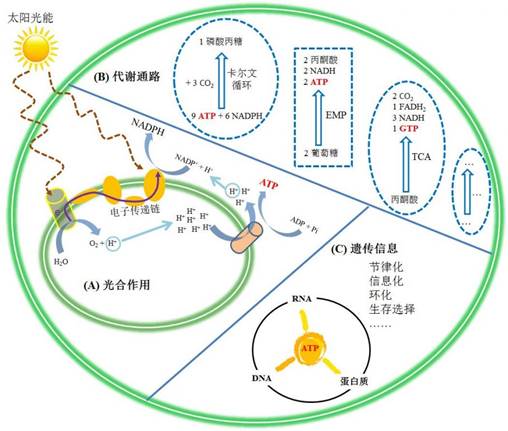
图5 作为能量和信息的载体的ATP在现代细胞中位于生化系统的中心,它在光合作用、代谢通路和遗传信息之间架起了桥梁
原始生命系统的演化就是一种光能驱动下的规律性的建构过程,大自然中的生命法则或规律是从随机性中创造出来的(如各种生化循环),这是一种从混沌走向秩序的过程。譬如,在机缘中,跨膜质子梯度(与肽链通道耦联)导致了ATP合成机构的成型,而ATP又推动了多肽合成体系的诞生。在事件的规律性或重现性中实现了信息化——建立起特定的t-RNA携带特定的氨基酸、以及t-RNA氨基酸接受臂吻合反密码子这样的结构体系,当然,这亦是一种随机的筛选过程。最后,迎来了一个统一的蛋白质合成平台——根据mRNA模板来制作多肽链的rRNA的诞生。简言之,原始生命的演化就是一种与光合作用相耦联、从随机性中筛选出节律性或规律性的生化系统创建过程,而所有这些筛选均是以生命的个体性存在为前提的。
信息在节律化或规律化的过程中必然产生,因为没有信息,节律或规律将失去意义,而物质亦只能停留于混沌之中。这样,信息化就是生命系统演化的必经之路,因此,一个集编码、保存、复制和翻译等于一体的信息系统的登场也就瓜熟蒂落了。
ATP(及其衍生的核苷酸)缩合成的核酸承担了信息的编码、保存、复制和翻译的功能(这亦适合其结构特点),它选择编码氨基酸去生产蛋白质,而核酸还承担了蛋白质生产车间的功能。由氨基酸构成的蛋白质高效催化几乎所有的生化反应(称之为酶),它按照DNA的指令去构建生命,是生命活动的实践者。如果以建筑一栋房屋为比喻,DNA是一个设计蓝图,RNA是工程师,蛋白质是各种建筑工人,形形色色的生命构件就是砖砖瓦瓦的建筑材料,他们的有序合作才能建成一栋风格独特的房屋。
2. 信息整合——从mRNA到DNA
既然光合作用只生产ATP,那么,从ATP向其它几种核苷酸的转化就不会困难。因携带有高的活化能,三磷酸化核苷酸可以自动缩合成各式各样的mRNA,而既然可以聚合成mRNA,那再拼接出更长的核酸(DNA)亦是水到渠成之事。从mRNA走向DNA是生化系统信息化逐渐完善的一个标志,用DNA来记录所有的遗传信息,而mRNA变为专门司职于遗传指令执行的一个环节(信使)。
在信息的整合过程中,终产物DNA与RNA在结构上出现了细微的差异:在核糖的第二个碳原子处前者是—H后者是—OH,碱基也变换了1个,即DNA中的胸腺嘧啶T在RNA中被尿嘧啶U所取代,当然两者的差别十分细微,也就是T多了一个甲基(图6)。没人能回答为何碱基相异的是1个而不是4个。在结构上或许并无多大意义,只是在于区别,因为类似的例子亦不罕见(譬如NADPH和NADH),除非RNA多样的立体结构来源于核糖或碱基的细微变化。这或许仅仅只是一种随机筛选的结果。
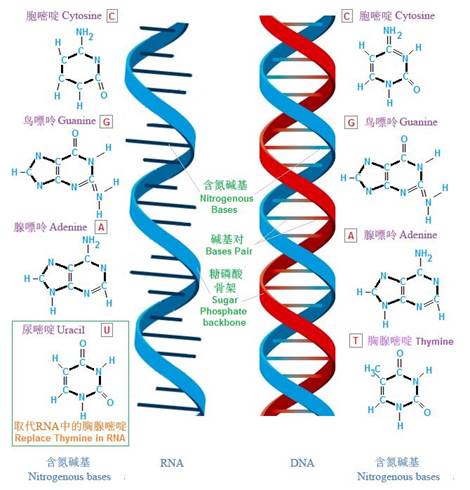
图6 脱氧核糖核酸(DNA)和核糖核酸(RNA)基本结构的比较(引自TutorVista.comTM)
为何生命要分离出两套独立的系统——RNA和DNA?这似乎是为了实现对细胞内成百上千同时发生的生化反应进行有序的信息管控,因为在生命构建与运行过程之中,mRNA的使命完成之后,马上就被销毁掉,而DNA所记录的遗传信息则是要永久保存的,这是种族延续的根本。
3. 密码子——从混沌走向秩序
原始生化系统应该就是光合作用演化的产物,在光合产物不断堆积、细胞不断破裂的循环过程中,逐渐从混沌走向秩序,在不断完善的信息化过程中,实现了同质性个体(当然并非绝对)的生产,最终形成了一套对生化系统进行有序管控并能在母体分裂过程中向子代稳定传递的密码系统。细胞只有能成功进行信息化管控,重复产生出同质性个体,才是真正生命实体的开端,才出现了真正意义上的物种,才开始了物种的演化历程。
密码子是生化系统自我组织的产物。在脂质囊泡中,以ATP为代表的核苷酸可自身缩合,一些可携带氨基酸,一些构建氨基酸缩合的平台,合成的多肽又可参与构建细胞膜中亲水分子/离子的跨膜通道,强力助推光合效率,并高效地催化核苷酸的自我缩合……这是一个从随机性中筛选出规律性的过程(即所谓的“自组织”),通过个体的生存选择不断地对生化系统进行优化与完善。多肽的秉性是参与催化几乎所有的生化反应过程。
由于核苷酸能够活化氨基酸,因此,最初的肽链生成可能是一种随机过程。在同质性个体选择压力下秩序化的结果可能导致了在特定的模具(rRNA)中,逐渐发展出根据mRNA链来合成特定多肽链的机构和规则(如在立体化学机制作用下的反密码子和密码子的配对原则)。
密码子的形成并不需要外在的设计,它不过是从随机性中筛选出合理性(通过个体存在的选择压力)的一种化学过程。而三联体密码子正好可以处理20多个氨基酸的分类管控,少了不行,多了累赘,即它是满足氨基酸编码最低需求的密码子数。
4. ATP——遗传密码子的始作俑者
如果从能量的普适性以及现代生化系统的结构特征来看,生命最有可能始于光合系统的演化(谢平2014)。支持这一观点的一个重要分子证据就是细胞色素(一类以铁卟啉或血红素为辅基的电子传递蛋白),这是一个存在于几乎所有生物之中的电子载体,而血红素可能就是从光合色素——叶绿素衍生而来的(现存生物中两者生物合成途径亦十分相似),只是叶绿素含有镁卟啉环,它可能由卟啉环与长链脂肪酸(可能来自膜)加合而成(图7)。
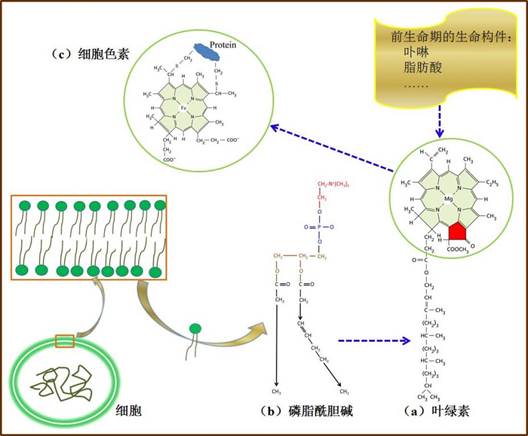
图7 叶绿素与细胞色素的血红素辅基之间在结构上的相似性。在从镁卟啉到铁卟啉的转变中发生了去环化作用(红色标记位置)。从进化上来看,膜耦联的叶绿素分子可能由磷脂与卟啉环加合而成。带箭头的蓝色虚线表示可能的演化方向
因此,密码子及其耦联的生化系统应该是在太阳光能驱动下、在相对封闭的系统(如脂质囊泡,可以推测原始地球上的脂肪酸就能自动形成类似于细胞膜的双层球状结构)中物理化学过程的产物,而这个过程的核心就是光能的捕获、传递以及由此推动的水的生化裂解过程,并伴随着跨膜电子与质子的流动或传递。在这样的事件之链中,一个看似平凡的有机分子——ATP却创造了诸多生命世界的奇迹:(a)它是光能转化成化学能的终端;(b)导演了一系列的生化循环(如卡尔文循环、糖酵解和三羧酸循环等)及令人眼花缭乱的元素重组;(c)它通过自身的转化与缩合将错综复杂的生命过程信息化——筛选出用4种碱基编码20多个氨基酸的三联体密码子系统(43 =64,还有相当大的编码冗余)、精巧地构建了一套遗传信息的保存、复制、转录和翻译以及多肽链的生产体系;(d)演绎出蛋白质与核酸互为因果的反馈体系,并在个体生存的方向性筛选中,构筑了对细胞内成百上千种同步发生的生化反应进行秩序化管控(自组织)的复杂体系与规则,并最终建立起个性生命的同质化传递机制——遗传(图8)。因此,在无数的有机分子中,只有ATP才是遗传密码子的始作俑者!
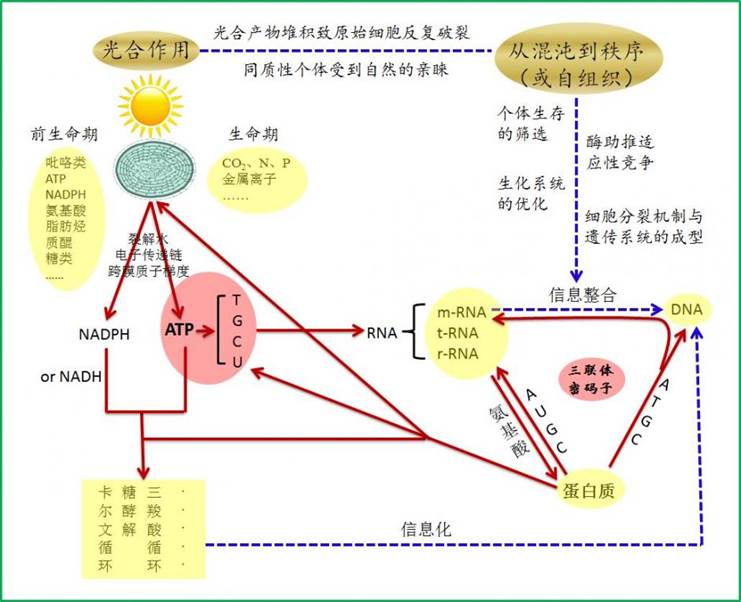
图8 密码子的起源——光合作用介导的ATP中心假说(ATP-centered hypothesis)示意图。蓝色虚线表示前生命期的演化过程,红色实线表示演化或作用从前生命期一直延续到生命期。箭头表示作用或影响方向。
四、密码子——为何“一妻多夫”?
已知一种tRNA只能携带一种氨基酸,这表明密码子与反密码子之间的配对还是十分严格的。但是,tRNA的反密码子如何才能与其相应的氨基酸之间建立起结构上的关联性呢?让我们假设在演化的早期没有酶协作的可能情景。可以推测,如果一种氨基酸可被多达6个不同的密码子所编码,那tRNA的氨基酸接受茎与氨基酸分子之间的立体识别就必须具有相当的可塑性,这就要求反密码子环的反密码子给予氨基酸接受茎与氨基酸之间更多的立体化学相互作用(配对)柔性,这可能只能依赖于一种整体性的随机筛选,因为氨基酸接受茎与反密码环在空间上是隔开的,这亦是打开编码可塑性空间的可能途径。显然,这条途径没有被生物界所采纳。
而我们在现存生物中见到的情形却是,一种酶(氨基酰tRNA合成酶,aminoacyl-tRNAsynthetase,简称aaRS)在tRNA氨基酸臂上所携带的氨基酸与反密码子之间架起了桥梁,因为酶的空间扩展能力与柔性容易克服这样的困难。一般情况下,aaRS至少包含一个催化核心结构域(catalyticcentral domain, CCD)和一个结合反密码子的结构域(anticodon-bindingdomain, ABD)。tRNA的氨基酸接受茎(即3’-端CCA-OH),在aaRS的催化下,与经ATP活化的氨基酸通过脂键结合。携带同一个氨基酸的所有tRNA(也称为同功tRNA)由相同的aaRS所催化,而每种酶通过若干特殊碱基来识别同工的tRNA。已知aaRS与呈L型的tRNA的内侧面广泛结合(图9)。
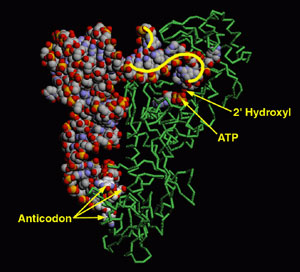
图 9色氨酰tRNA合成酶(tryptophanyl-tRNAsynthetase)的晶体结构(来源:生物谷Bioon.com)
在tRNA分子中,有些区域决定了其所携带的氨基酸种类,称之为副密码子(paracodon),但其位置并不固定(这与反密码子完全不同),可分布在氨基酸柄、反密码子环、D环和TyC环上。副密码子可以是一个碱基对(譬如,tRNAAla的氨基酸柄上的G3·U70似乎是tRNAAla的副密码子),亦可能不止一个碱基对。不难理解,因为反密码子是要在立体结构复杂的核糖体中与mRNA严格配对的,所以,它在所有tRNA中的位置都必须是固定的,因核糖体也不止是接纳一种tRNA。但aaRS就完全不同了,它与tRNA只是一对一的关系,而蛋白质结构的可塑性就使得副密码子的位置以及密码数都可能更为随机。此外,正因为酶的介入,才使得一种氨基酸能被多个密码子所编码。还有,为何每个氨基酸密码子都要有一个对应的tRNA?这或许是为了满足多肽链合成的速度需求吧。
类似地,标准密码子的偶然变异亦不足为奇。虽然绝大多数生物都使用相同的密码子来编码蛋白质,也有极少数的例外(表1),这多见于线粒体基因组(线粒体携带有自己的DNA——mtDNA,能合成有限的蛋白质种类,但构成线粒体的蛋白质的绝大多数由核DNA编码并在细胞质核糖体上合成后再运送到线粒体特定的功能位点上)。当然,只要在特定的生物中,其生化系统的运行能适应这种看似“异常”的密码子,亦无大碍。
表1 标准遗传密码及其变异
|
密码子 |
通常编码 |
例外编码 |
所属生物 |
|
UGA |
中止 |
色氨酸 |
人、牛和酵母的线粒体,支原体基因组 |
|
UGA |
中止 |
半胱氨酸 |
一些纤毛虫细胞核基因组,如粘游仆属(Euplotes) |
|
AGR |
精氨酸 |
中止 |
大部分动物线粒体,脊椎动物线粒体 |
|
AGA |
精氨酸 |
丝氨酸 |
果蝇线粒体 |
|
AUA |
异亮氨酸 |
蛋氨酸 |
一些动物和酵母线粒体 |
|
UAA |
中止 |
谷氨酰胺 |
草履虫、一些纤毛虫细胞核基因组,如嗜热四膜虫(Thermophailus tetrahymena) |
|
UAG |
中止 |
谷氨酸 |
草履虫核细胞核基因组 |
|
GUG |
缬氨酸 |
丝氨酸 |
假丝酵母核基因组 |
|
AAA |
赖氨酸 |
天冬氨酸 |
一些动物的线粒体,果蝇线粒体 |
|
CUG |
亮氨酸 |
中止 |
圆柱念珠菌(Candida cylindracea)细胞核基因组 |
|
CUN |
亮氨酸 |
苏氨酸 |
酵母线粒体 |
(来源:百度百科)
五、DNA——对适应性演化的信息镌刻
如果不能保存,信息有何意义?而保存(通过DNA)就是对适应性的一种镌刻,同样没有它,演化亦不复存在。正是这样一种神奇的机制使生命铸就了惊人的适应性。譬如,多肽链的柔变性为其高效的酶催化功能奠定了基础,而竞争性存在的选择压力使这种特性登峰造极:乳清酸核苷5'-磷酸脱羧酶所催化的反应在无酶情况下,需要7800万年才能将一半的底物转化为产物,而在这种脱羧酶的催化下,同样的反应过程只需要25毫秒(Radzicka andWolfenden 1995)。也就是说,酶的高效性依赖于竞争性生存的筛选,换言之,如果没有这种筛选力量,酶不可能如此高效。
或许,水的裂解是大自然适应性演化的最大奇迹。H2O中O-H键是一种稳定的共价键,平均键能高达463 kJ mol-1,在普通的太阳光照射下很难裂解。而生命用平凡的原料创造了神奇:光能、多肽、金属离子(锰、钙)和非金属离子(氯)。水氧化酶通过金属离子与水分子的非共价结合,将H2O的O-H键撕开,夺走电子,释放H+(铸就了永不衰竭的ATP合成)和O2(成全了动物界的繁荣)。这一化学事件的重要意义在于,生命在相对温和(普通的太阳光能下)的条件下找到了一种从普遍存在但难以裂解的H2O中获取电子和质子的方法,从此拉开了生命在地球上快速扩张的序幕。
六、生命扩张——打通与ATP耦联的所有代谢通路
生命几乎遍布了地球上液态水可存在的所有角落,呈现出如此惊人的扩展力!现在的任何一种生命都是无与伦比的复杂,都不可能是生命一诞生就能达到的复杂程度。生命的演化必定始于一些基本的构件物质(如果我们不承认这一点,那就得借助神明,而这就不是科学了),从随机性中筛选出规律性,这是一个漫长的过程(长达数亿年之久)。这种筛选是通过个性化的存在来实现的,即存在就是一种方向性的选择力量。之后,发展出从更简单的原料实施所有生化合成/分解的体系,这一体系包含了一些重要的生化循环,而最重要的能量来源就是ATP,当然还有用于还原碳的氢载体——NAD(P)H(亦是核苷酸的衍生物)。之后,与ATP耦联的所有生化循环之连接通道被打通,生命得以实现大范围的扩张。
所用这些简单原料均来自光合作用,即尽可能地利用光合作用的产物来实现生命的构建,除了需要补充一些光合作用不能获得的元素,如P、N等。太阳光能——永不衰竭,水——永远循环,CO2——无处不在……这些为地球上生命的繁荣奠定了重要的物质和能量基础!
七、谁是RNA世界的真正推手?
恕我直言,迄今为止所有关于遗传密码子起源的假说都无视生化系统演化的玄机(而分子生物学家更像是一些手艺精巧但思维刻板的工匠),从密码子本身不可能窥见密码子演化的秘密,即便他们将眼光扩大到密码子与氨基酸之间的可能关系,结局亦会如此。密码子经历了从简单到复杂的演化过程,这是不言而喻的(有学者将其划分为几个时期:前密码子期、tRNA形成期、原密码子链与有序肽同步起源期、密码子进化期)。密码子与氨基酸之间存在立体化学联系,这亦毋庸置疑(如果否认这,就会坠入神创论或设计论的泥潭)。问题是,密码子的演化必须有动因,是随机性或是其它呢?
离开个体性,生命演化将失去意义。那些主张大分子(蛋白质和核酸)在体外演化的学说(如艾根,他甚至发明了“分子拟种”,将达尔文的理论生硬地套到了其大分子演化设想之中)只能是无稽之谈。原始生化系统的演化就是一种在个性系统中受太阳光能的驱动从随机性筛选节律性或循环的过程,这种筛选就是通过个体的存在(亦可称之为合理)来实现的。各种生化循环(如卡尔文循环、糖酵解和三羧酸循环等)的起源亦如此,但演化的轨迹早已消逝。正如古希腊哲学家赫拉克利特所言,“在圆周上,起点和终点是重合的”。至此,蛋白质与核酸的所谓“鸡”与“蛋”悖论也就迎刃而解了。
也许有人会问,为何大自然不停留于有机汤的世界?或者说为何它从混沌走向了秩序?这从表象上来说是太阳光能不断输入的结果,但本质或许是因为可遗传的同质性个体得到了存在的青睐(恰如德国哲学家黑格尔的一句至理名言——“存在即合理”)。个体性即意味着欲望、竞争或斗争——这即为动因,随后,演化才能水到渠成。此外,有了个体性,生化反应的节律化或规律化才有可能,这亦是适应性的基础。其实,这样的禀性延续到了高等生物之中,譬如,我们熟知的习性与本能就是如此。
Woese(1967)提出了RNA世界学说(RNA world hypothesis,该词由诺贝尔化学奖得主Walter Gilbert于1986年造出),认为地球上早期的生命分子以RNA先出现,之后才是DNA,早期的RNA分子同时拥有如同DNA的遗传信息储存功能,以及如蛋白质般的催化能力,支持了早期的细胞或前细胞生命的运作。笔者反对这种RNA无中创造出生命世界的说法,虽然认同RNA早于DNA出现的观点。有何证据说RNA具有信息储存功能和催化功能生命世界就一定起源于它?还有,该学说亦无法说明RNA分子为何要储存遗传信息以及为何要去支持前细胞生命的运作。
RNA世界学说是一个缺乏演化动因(亦缺乏个体性)的臆想,它对生命起源的解释相当牵强。笔者提出一个替代的名称——光合驱动的ATP世界学说(photosynthesis mediated ATP worldhypothesis),即以ATP为核心的前细胞生命运作起因于脂质囊泡结构中开始的光系统演化。只要细心剖析现存生命的生化代谢系统——膜耦联的光反应系统——遗传信息系统等的结构特征(光合色素、电子传递链、利用跨膜H+梯度合成ATP的ATPase 、DNA链的RNA引物等)及其关联性,一切就会幡然醒悟!不过,如果大家不愿舍弃RNA世界一词的话,那始作俑者也应该是核苷酸ATP,它才是RNA世界的真正推手!
或许人们会抱怨这个“ATP中心假说”叠加了太多的推测,但我可以自信地说,这个素描在整体轮廓或逻辑上比以往任何一个学说都要清晰,特别是将遗传密码子的起源与光合作用介导的以ATP为核心的生化系统的演化相耦联(一些关联性细节见谢平2014)。当然,我亦承认,关于密码子或生命起源的所有假说或理论既不能证实,也无法证伪(这在科学哲学家波普尔的眼中,就是非科学了),过去和现在一样,将来亦可能如此。但是,因为它关乎我们自身的秘密,在水落石出之前,人类不可能终结追寻。人们从密码子与生化系统的内在关联之中可以窥视它们可能的协同演化机密——这虽不见得就是真理,但至少会是一条通向真理之道!
对本文内容的引用:谢平. 2016. 进化理论之审读与重塑. 北京:科学出版社
Xie P. 2016. Critical Reviews and Reconstructionof Evolutionary Theories. Beijing: Science Press (in Chinese)
Cracking mystery of genetic codes
Ping Xie*
Donghu Experimental Station of LakeEcosystems, State Key Laboratory of Freshwater Ecology and Biotechnology ofChina, Institute of Hydrobiology, Chinese Academy of Sciences, Wuhan 430072,People’s Republic of China
* E-mail: xieping@ihb.ac.cn
Abstract:
More than half a century has passedsince the discovery of genetic codes, but their origin is still one of thegreatest mysteries in modern life science. Are the genetic codons really unknowable? Do they really require external design? Here, I present an ATP-centrichypothesis aimed at exploring the hidden primordial world inspiring the originof genetic codes. I examined how and why ATP is at the heart of the extantbiochemical system, and how the genetic codes came into being with theevolution of biochemical system driven by photosynthesis. It is challenging tocrack the mystery.
Background
It is a miracle of nature that a set ofgenetic codes have assembled tens of millions of different species on theearth. But no one knows exactly how these genetic codes came into being. Biologists,probably a majority, hold a pessimistic view that an exact reconstruction ofthe process of code construction may never be possible [1]. Yockey [2] claimsthat the origin of the genetic code is unknowable, as there is no trace inphysics or chemistry of the control of chemical reactions by a sequence of anysort or of a code between sequences. He criticizes that many papers have beenpublished with titles indicating that their subject is the origin of thegenetic code, but actually the content deals only with its evolution.
So far, several hypotheses have been proposed. The frozenaccident hypothesis states that allocation of codons to amino acids in thesingle ancestor was entirely a matter of “chance”,and then remained unchanged [3]. The stereochemicalhypothesis claims that there is in many cases a specific stereochemical fitbetween the amino acids and the base sequence of its codon on the appropriatetRNA [4]. The biosynthetic hypothesis postulates that the code was assigned inparallel to the evolution of amino-acid biosynthesis [5]. Knight et al. [6] declaresthat the genetic code is a product of selection, history and chemistry. Sincethen, very little definitive progress has been made, although intensive studieshave focused on variation or flexibility of the codes and possible rules of codonallocations to amino acids [7-10].
Frankly speaking, these hypotheses suffer from twofatal defects: first, none can explain satisfactorily why the genetic codesevolved in such a way, and second, none has explained the origin of geneticcodes from that of the biochemical system (a relation of part to whole). Inother words, all these hypotheses completely overlooked the coevolution of thegenetic codes with biochemical system. In my view, it is impossible to crack thesecret of codon origin just from the codon itself [10, 11], even extendingvision to the possible relationship between codon and amino acids [7].
Another source of the problem may berelated to a so called quasi-species model proposed by Eigen [12]. He strongly advocated in vitro evolution of macromolecules. A quasi-species in theenvironment was imaged to be a population of genetically related RNA moleculeswhich had certain morphological commonness but were not identical. He supposedthat the quasi-species followed the Darwinian process of natural selection.This model has been highly influential [1], which, in my view, is among the mainobstacles in our understanding the origin of the geneticcodes.
There is an associated problem. Molecular biology hasbeen long troubled by the so-called chicken-and-egg paradox of protein and nucleic,seemingly a logically circular debate about who appeared first. It is alsocertain that the cues about the origin of macromolecules have been completelylost, due to cyclizing of biochemical paths where the transitional states or trackshad long disappeared. Just as the ancient Greek philosopher Heraclitus said,the beginning and ending point are overlapped on the circumference of a circle.
It is undeniable that codon and amino acids had beenlinked stereo-chemically [4]. Otherwise, we will fall into the mire of God'screation or design. The problem is that the birth of the genetic code must havebeen motivated by some forces. Randomness and selection were frequentlyconsidered to be the ones, but I do believe they are ways rather thanmotivation. Motivation should be energetic, e.g. ATP produced byphotosynthesis.
It is beyond all doubt that design of the geneticcodons, a chemical language, never required the intervention of a “hidden hand”.However, currently, no reliable fossil evidences are available, and eons ofevolution have blurred the molecular vestiges of the early events that remainin living organisms [13]. But fortunately, we can still look back at thehistory from the extant, even our eyes can perceive only a very minute fractionof the history of the early life.
How is a biochemical system organized?
To solve the puzzle of the genetic codes, we mustfirst understand how a biochemical system is organized. Consider what is alife. Life, compositionally, is a unity of matter, energy and information, anddynamically, is a “game” of material cycling, energy flows and informationcommunication. Energy is the key to support life system. In the past decades, physicistsand chemists have discovered a lot of details about how organisms are structuredand how they work. It is known that life is a physiological machine where inconceivablynumerous biochemical reactions are taking place toacquire, convert and use energy. In all modernautotrophic life forms (plants, algae and somebacteria), the only source of energy is from sunlight that is converted intochemical energy by a series of complex physico-chemical processes called asphotosynthesis [14].
Energetically and informatically, nothing inbiochemical system is more important than a nucleotide, ATP. It is the only energeticproduct of photosynthesis, carrying chemical energy converted from sunlight. Itthen provides energy for metabolisms through conversionsof ATP/ADP/AMP, supporting transformation of various biomolecules into eachother in an exquisitely organized cell. In other words, the major metabolicpathways (e.g. the Calvin cycle, glycolysis, and the Krebs) are all coupled withATP (Fig. 1).Of course, NAD(P)H,a derivative of nucleotide, is alsonecessary, as it transports H and e- (through conversion of NAD(P)H/NAD(P)+).
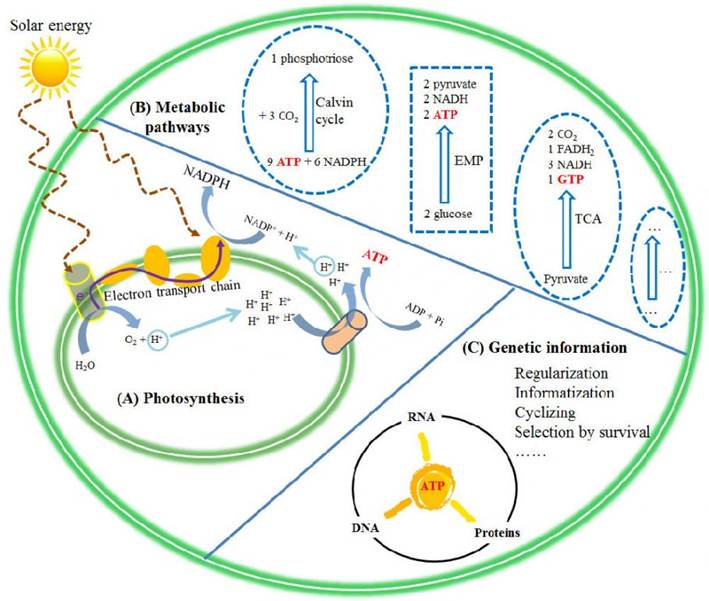
Figure1. ATP (a carrier of both energy and information) is at the center of the biochemicalsystem in a modern cell. Itprovides a unique bridge among photosynthesis, metabolic pathways and genetic information
ATP is not only an indispensablebuilding block of the genetic system (DNA, and RNA), but the other four nucleotides for genetic coding are also allderived from it. While, information delineates the border between the livingand the inanimate, as the living world appears as the only place whereinformation is recorded, processed, or used [15]. Therefore, as anirreplaceable carrier of both energy and information, ATP appears asnecessarily having a central role in the biochemical system.
The importance of ATP in biochemical systems couldbe attributed to its role in governing the evolution of photosynthetic systems inprimordial life. Although debated, there are signs that life on earth did startout with photosynthesis [16]. First, sunlight, needless to say, has been themost universal source of energy. Second, a biomolecule called cytochrome (an electrontransport protein with iron porphyrin or heme as a prosthetic group) seems tobe imprinted with photosynthesis (Fig. 2). Cytochromeis a universal electronic carrier, but present even in chemoautotrophicbacteria [17]. Originally, the heme was likely derivedfrom a photosynthetic pigment, chlorophyll, as their biosynthetic pathways arevery similar in extant life forms [18]. Interestingly, chlorophyll seemedan adduct between a magnesium porphyrin ring and along chain fatty acid from the membrane. Let me ask, if photosynthetic bacteriawere not the Last Universal Common Ancestor (LUCA) of all modern life forms, why had the chemoautotrophic bacteria used a photosynthesis-imprintedmolecule likecytochrome as an electron carrier?
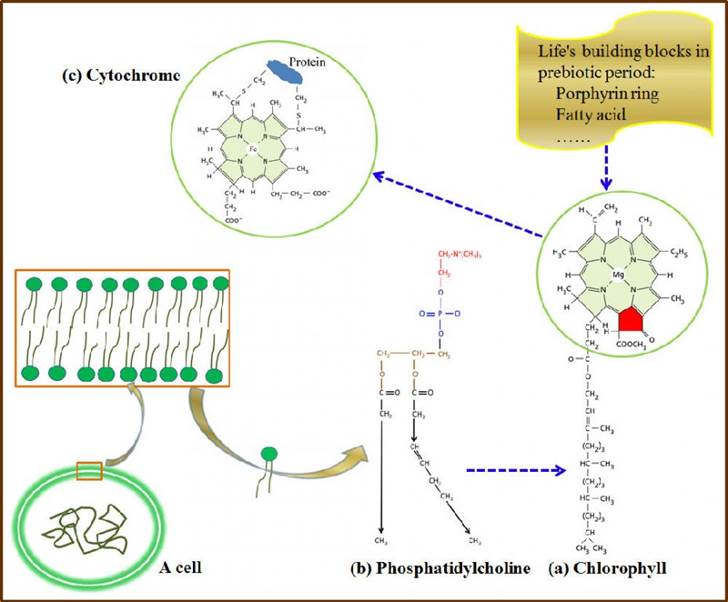
Figure2. Structural homology between chlorophyll and the heme of cytochrome. Decyclization occurred from magnesiumporphyrin to iron porphyrin (marked with red color). Evolutionarily, the membrane-boundchlorophyll was likely a merge of phospholipid and porphyrin. Dashed blue lineswith arrows indicate possible directions of evolution
How did the genetic codes originate?
The genetic code system was built by achemical mechanism closely related closely with the production of ATP. Energetically,the first job the primordial life should do was how to achieve sufficientproduction of this nucleotide. While in present-day photoautotrophs, synthesisof ATP requires a transmembrane gradient of protons that come from biochemicalcleavage of water in photosynthetic system. Therefore, to guarantee such a protongradient, there was first needed a relatively closed entity or a small room, impermeableto H+. Such cubicles were most likely a lipid vesicle, the precursorof protocell. The fact that synthesis of ATP requires a transmembrane gradientof H+ made it impossible for macromolecules to evolve in vitro as suggested by Eigen.
Chemically, it was not impossible, onthe primitive earth, that fatty acids couldautomatically form a double-layered globular membrane structure [19]. In modern life forms, cell membrane, consisting of lipid (phospholipid)bilayer, provides controlled entry and exit ports for the exchange of matter. Itpermits passing through of small molecules such as CO2 and O2by diffusion, but acts as a barrier for certain molecules and ions (e.g. H+),leading to different concentrations on the two sides of the membrane. H+cannot pass freely across the membrane, unless using transmembrane proteinchannels. This implies that the formation of ATP in primordial cell had to relyon polypeptide channel that then developed into ATP synthase. In addition, H+from cleavage of H2O also needed the help of polypeptides.
Reasonably,fluent production of ATP was possible only if the various elements (sunlight,lipid bilayer membrane, polypeptides, cleavage of H2O, transmembraneH+ gradient, electron carrier……) had be organized orderly. It may beinferred that there were a series of events randomly occurring in protocells. Forexample, the transmembrane proton gradient coupled with polypeptide channelresulted in the formation of an apparatus (i.e. ATP synthase) to synthetize ATP.Nucleotides like ATP could form polynucleotides by self-condensation, some ofwhich carried amino acids (precursor of tRNA), and others built platform forthe synthesis of polypeptides (precursor of rRNA), which assumably replaced theirregular stochastic formation of polypeptides from amino acids activated by ATP.On the other hands, the polypeptides in turn participated not only in theconstruction of the transmembrane channels of hydrophilic molecules/ions, butalso in the biochemical cleavage of H2O, and in catalyzing self-condensationof nucleotides as well. As a consequence, numerous consecutive reactions werelinked into a variety of chains, which might be linear, branched, or cyclic. Fundamentally,these were creative processes of order out of disorder, and of rationality outof randomness.
Itshould be borne in mind that primitive life started out from materials thatwere not organized. The prebiotic mixtures of chemicals, present on theprimeval earth, were assumed to contain an immense number of life’s buildingblocks such as ATP, NADPH, pyrroles, amino acids, aliphatic hydrocarbons,ubiquinones, monosaccharides, and so on [16]. Let us first consider the impermeablelipid vesicle wrapping a plenty oflife'sbuilding blocks. Their exposure to sunlight would drive dazzling flows ofelectrons and H+, causing active re-combinations of elements. This wouldincrease accumulation of large molecules, but accompanied with ceaseless inputof small molecules like CO2……and therefore, the protocells had to reciprocatebetween enlarging and rupturing, giving rise to the developments of both photosynthesisand cell division. Next, an information era followed: in the cycle of photosyntheticgrowth followed by division, and also through the selection of individualsurvival, the protocell got used to fixiate regularity, reproducibility and rhythmicityof various biochemical reactions in dealing with photosynthetic products, whichcan be called information-based or informatization.
Then, a scenario of how a set of geneticcodes were successfully selected to record, preserve and transmit informationcan be outlined. Firstly, it was likely that in the organic “soup” enclosed bythe protocell, the energetic ATP with its derivatives could randomly extendchains of both polynucleotides and polypeptides, which made it possible toestablish or fix the chemical relation between sequences of nucleotides inpolynucleotides and amino acids in polypeptides from their numerous randomcombinations through selection of cellular survival, an ecological force or afeedback mechanism.
Secondly, informatization was inevitablycoupled with structuralization, such as structural subdivision orspecialization and functional differentiation, providing basis for theestablishment of the triplet codon system. For example, t-RNA was specializedto carry specific amino acid, polypeptides helped matching the acceptor stem oft-RNA to its anticodon, and the system developed the rule of codon-anticodonbase-pairing i.e. molecular recognition, through stereochemical interactions, e.g.hydrogen bonds, van der Waals attractive forces and aromatic stacking, and usheredin a unified platform, r-RNA, for protein synthesis (synthetizing polypeptidesaccording to m-RNA template), and so on. In this way, macromolecules werefunctionally differentiated, i.e., handling (record, preserve and transmit)information by polynucleotides and catalyzing all chemical reactions bypolypeptides called as enzymes, and both were further cyclized into a system ofreciprocal causation. As a result, the codes-based informatization led to fantasticinnovations of diverse laws (principles) or patterns, e.g., biochemicalpathways, of course through a goal-oriented random selection (Fig. 3).
Thirdly, the triplet codon might just bea result of the optimization of biochemical networks under selective pressure,i.e., for handling more than 20 amino acid, it was not so good either too much(more cumbersome) or too little (43=64, thus there is still considerable redundancy of encoding). Namely, triplet was the lowest codenumber to encode the amino acids.
Of cause, it must have been a very long successionof steps for the protocells to test and modify the genetic code system throughthe selection of cellular survival. Then, they obtained the capacity totransmit their blueprint recorded in DNA from generation to generation, andself-building also became a central characteristic of life. The protocell hadtherefore taken a historic step towards the first genetic cell, i.e. a truespecies, that could bear, process and transmit information, reproducinghomogeneous, although not absolutely, individuals, and thus capable of Darwinianevolution. It seemed to be a first principle that reproduction of individualswith hereditable homogeneity was favored by existence or nature, which -somewhat like a centripetal eco-physiological force - not only governed the integrationof various biochemical events, but also shaped the direction of survivalselection.
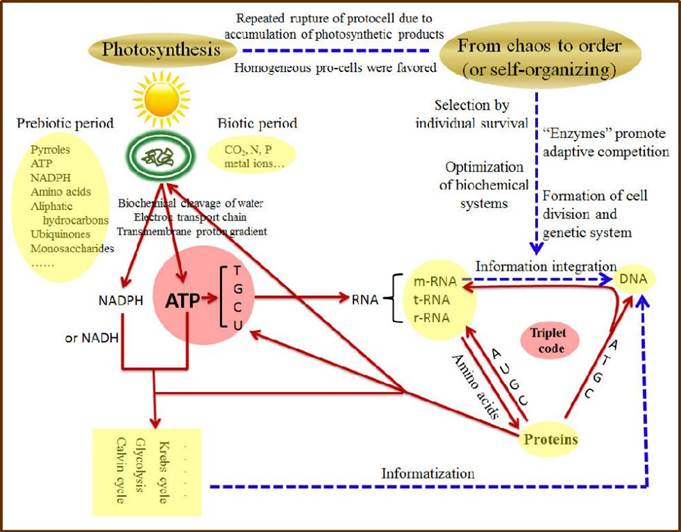
Figure 3. A simplified conceptual model on the origin of thegenetic code based on the photosynthesis-mediated and ATP-centric hypothesis. Dashed blue lines indicate evolutionaryprocesses during pre-life period, while solid red lines denote processes orinteractions from pre-life period to the present. Arrows indicate the directionof influences or actions.
What made the difference between DNA andRNA?
As ATP is the only nucleotide producedby photosynthesis, it did not appear difficult to convert ATP to any othernucleotide. Meanwhile, these energetic nucleotides could also self-condenseinto a wide variety of mRNA, of course also other RNAs. If they could do this,why was it impossible for them to extend the chain to make a DNA molecule? Theprogress from mRNA to DNA was undoubtedly a great step of the informatization inbiochemical system. That is, DNA was specialized to accurately record and permanentlypreserve all genetic information that command all that goes in the cell, whilemRNA became short-lived messengers for the implementation of the instructions.
However, in the integrative process ofinformation, there were subtle structural differences between DNA and RNA.First, the second carbon atom of the ribose connected -H in the former, but -OHin the latter. Second, thymine T in DNA was replaced by uracil U in RNA, ofcourse, the structural difference was very small, i.e., T had more than onemethyl group. No one can answer why base differences were 1 rather than 4. It seemsunbelievable that this had much meaning in structuralization, perhaps justbecause of a need in difference, as similar cases were not rare, e.g. NADPH andNADH, unless the diverse three-dimensional structures of RNA were due to such atiny change in ribose or base. Structurally, this was more likely just an accident.But functionally, subdivision of the genetic system into RNA and DNA was certainlyfor orderly management and control of information in a tiny cell where hundredsof biochemical reactions occur simultaneously. Consequently, the biochemicalsystem came to a status where mRNA were immediately destroyed after theirmission was finished, while the genetic information recorded by DNA would bepermanently preserved and transmitted to ensure the continuation of the species.
Who manipulated the RNA world?
Woese [20] proposed the RNA world hypothesis (a termcoined by Walter Gilbert in 1986): the earliest biomolecules on earth were RNA,and then DNA; the early RNA molecules had the abilities of information storageas DNA and catalysis as proteins, and supported the operation of the early cellor the protocell life. I object to such a statement that RNA created the lifeworld from randomness, although agreeing with the view that RNA was earlierthan DNA. Is there any evidence to say that the world of life must have beenderived from RNA as it has the functions of information storage and catalysis? Also,this theory is unable to explain why the RNA molecules tended to store geneticinformation and to support the operation of protocells.
In my view, the explanation of the RNA worldhypothesis on the origin of life and the genetic codes is quite farfetched [21-23]and its lack of both motivation and individuality is unfortunate. I propose analternative term, the photosynthesis mediated ATP world hypothesis, i.e., theearly life on earth coevolved with the development ofphotosynthetic system in lipid vesicles where a sophisticated biochemicalsystem was built for a special purpose to synthetize ATP using solar energy.This is evidenced by a series of structural and functional features of the extantbiochemical system (e.g., photosynthetic pigments, electron transfer chain, ATPsynthesis by transmembrane H+ gradient, metabolic cycles/pathscoupled with ATP, synthesis of RNA and DNA by ATP and its derivatives, etc.)aswell as their interplay. However, if we are not willing to abandon the term of“RNA world”, well, the nucleotide ATP should also be the initiator.
Challenges in the Future
In this article, I outlined a syntheticmechanism for the origin of genetic codes: the energetic ATP together with its derivativescould randomly extend chains of both polynucleotides and polypeptides, whichmade it possible to establish or fix chemical relations between sequences of nucleotidesin polynucleotides and amino acids in polypeptides from their numerous randomcombinations through a feedback mechanism (selection of cellular survival); andtechnically, photosynthesis, a goal-oriented process, enabled various biotic factorsor reactions (ATP, lipid vesicle, informatization, structuralization, homogenousindividual, individuality, survival, etc.) to be integrated into an operatingsystem of genetic codes. But, it remains a challenge how to collect supportingevidences.
Perhaps some people will ask why moleculesdid not stay silently in the organic soup but struggled to shift from chaos toorder? We may attribute this to code-based self-organization with incessantinput of solar energy: would such codes not exist, the protocells would not beable to maintain orderly control of biochemical systems, and the chemical worldwould still stay in incomprehensible chaos. But, it is still needed to explainwhy. Is it a first principle that individuals with heritablehomogeneitywere favored by existence?
Life, in a sense, is a contradictory unity– it owns generality from homogeneity, but in the meantime possesses individualityfrom heterogeneity. Individuality can be traced back to the lipid vesicleswhere life started out. It is the quality that makes one living entitydifferent from all others. It is amazing that such individuality had advancedfrom pure chemistry in bacteria to sophisticated desire (e.g. for competition andstruggle), habits, instincts and even spirit in higher animals. Is it possiblethat individuality, as an eco-physiological force, engaged in re-shaping or re-fixingrhythm or regularity of biochemical reactions in the protocells? And then, Darwinianevolution could be a matter of course.
One may well wonder whether too much speculationhas been superimposed on the ATP-centric hypothesis. But, I can confidently saythat the present sketch is clearer than any one of the previous theories in theoverall outline or logic, particularly, relating the origin of the genetic codewith the evolution of the photosynthesis-mediated and ATP centered biochemicalsystem. And, of course, I admit that all the hypotheses or theories on theorigin of life or genetic code can neither be verified nor falsified (this isnot science in the eyes of Popper, a philosopher of science). This has been thecase so far, and perhaps will still be for a period of time in the future. But,because it is a secret about ourselves, and before the facts are completely known,human beings never stop pursuing. It is possible for us to spy on the secretsof coevolution between the codon and the biochemical system from theirintrinsic relationship - this is not necessarily the truth, but at least a wayto the truth.
References
1. RauchfussH (2008) Chemical evolution and the origin of life.Springer-Verlag Berlin Heidelberg.
2. YockeyHP (2005) Information theory, evolution, and the origin of life. CambridgeUniversity Press.
3. CrickFH (1968) The origin of the genetic code. J Mol Biol 38: 367-379.
4. WoeseCR, Dugre DH, Dugre SA, Kondo M, Saxinger WC (1966) On the fundamental natureand evolution of the genetic code. Cold Spring Harbor Symp Quant Biol 31: 723-736.
5. WongJTF (1975) A co-evolution theory of the genetic code. Proc Natl Acad SciUSA 72, 1909–1912.
6. KnightRD, Freeland SJ, Landweber LF (1999) Selection, history and chemistry: thethree faces of the genetic code. Trends Biochem Sci 24: 241-247.
7. OhamaT, Inagaki Y, Bessho Y, Osawa S (2008) Evolving genetic code. Proc Jpn Acad SerB 84: 58–74.
8. KooninE V, Novozhilov A S (2009) Origin and evolution of the genetic code: theuniversal enigma. Cell Mol Biol 61: 99-111.
9. ShahP, Gilchrist M A. (2011) Explaining complex codon usage patterns with selectionfor translational efficiency, mutation bias, and genetic drift. Proc Natl AcadSci USA 108: 10231-10236.
10. Baranov PV, Atkins JF, Yordanova MM (2015) Augmented genetic decoding: global, localand temporal alterations of decoding processes and codon meaning. Nature RevGenet 16: 517-529.
11. SciarrinoA, Sorba P (2013) Codon-anticodon interaction and the genetic code evolution. Biosystems111: 175-180.
12. EigenM (1971) Selforganization of matter and the evolution of biologicalmacromolecules. Naturwissenschaften58: 465-523.
13. LeslieM (2009) On the origin of photosynthesis. Science 323: 1286-1287.
14. UmenaY, Kawakami K, Shen JR, Kamiya N (2011) Crystal structure of oxygen-evolvingphotosystem II at a resolution of 1.9 Å. Nature 473: 55-60.
15. BattailG (2014) Information and life. Springer.
16. XieP (2014) The aufhebung and breakthrough of the theories on the origin and evolutionof life. Science Press (in Chinese).
17. MadiganMT, Martinko JM, Stahl DA, Clark DP (2012) Brock biology of microorganisms (13thed). Prentice Hall.
18. TaizL, Zeiger E (2010) Plant physiology (4th edition).Sinauer Associates.
19. WongJTF, Lazcano A (eds.) (2009) Prebiotic evolution and astrobiology. CRC Press.
20. WoeseCR (1967) The genetic code: the molecular basis for genetic expression. Harper& Row
21. ZimmerC. (2009) On the origin of life on earth. Science 323: 198-199.
22. AtkinsJF, Gesteland RF, Cech TR (eds.) (2011) RNA worlds: from life’s origins to diversityin gene regulation. Cold Spring Harbor Laboratory Press.
23. SenguptaS, Higgs PG. (2015) Pathways of genetic code evolution in ancient and modern organisms.J Mol Evol 80: 229–243.
This article should be cited as follows:
Xie P. 2016. Critical Reviews and Reconstructionof Evolutionary Theories. Beijing: Science Press (in Chinese)
联系方式:沈宏 徐军 027-86780056 Email:wetland@ihb.ac.cn
地址:武汉市武昌区东湖南路7号
访问数量:


 当前位置:
当前位置: